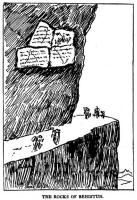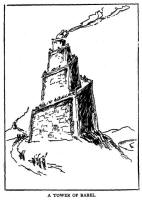|
THE SUMERIAN NAIL WRITERS
In the year 1472, a short time before Columbus discovered
America, a certain Venetian, by the name of Josaphat Barbaro,
traveling through Persia, crossed the hills near Shiraz and saw
something which puzzled him. The hills of Shiraz were covered with
old temples which had been cut into the rock of the mountainside.
The ancient worshippers had disappeared centuries before and the
temples were in a state of great decay. But clearly visible upon
their walls, Barbara noticed long legends written in a curious
script which looked like a series of scratches made by a sharp nail.
When he returned he mentioned his discovery to his
fellow-townsmen, but just then the Turks were threatening Europe
with an invasion and people were too busy to bother about a new and
unknown alphabet, somewhere in the heart of western Asia. The
Persian inscriptions therefore were promptly forgotten.
Two and a half centuries later, a noble young Roman by the name
of Pietro della Valle visited the same hillsides of Shiraz which
Barbaro had passed two hundred years before. He, too, was puzzled by
the strange inscriptions on the ruins and being a painstaking young
fellow, he copied them carefully and sent his report together with
some remarks about the trip to a friend of his, Doctor Schipano, who
practiced medicine in Naples and who besides took an interest in
matters of learning.
Schipano copied the funny little figures and brought them to the
attention of other scientific men. Unfortunately Europe was again
occupied with other matters.
The terrible wars between the Protestants and Catholics had
broken out and people were busily killing those who disagreed with
them upon certain points of a religious nature.
Another century was to pass before the study of the wedge-shaped
inscriptions could be taken up seriously.
The eighteenth century--a delightful age for people of an active
and curious mind--loved scientific puzzles. Therefore when King
Frederick V of Denmark asked for men of learning to join an
expedition which he was going to send to western Asia, he found no
end of volunteers. His expedition, which left Copenhagen in 1761,
lasted six years. During this period all of the members died except
one, by the name of Karsten Niebuhr, who had begun life as a German
peasant and could stand greater hardships than the professors who
had spent their days amidst the stuffy books of their libraries.
This Niebuhr, who was a surveyor by profession, was a young man
who deserves our admiration.
He continued his voyage all alone until he reached the ruins of
Persepolis where he spent a month copying every inscription that was
to be found upon the walls of the ruined palaces and temples.
After his return to Denmark he published his discoveries for the
benefit of the scientific world and seriously tried to read some
meaning into his own texts.
He was not successful.
But this does not astonish us when we understand the difficulties
which he was obliged to solve.
When Champollion tackled the ancient Egyptian hieroglyphics he
was able to make his studies from little pictures.
The writing of Persepolis did not show any pictures at all.
They consisted of v-shaped figures that were repeated endlessly
and suggested nothing at all to the European eye.
Nowadays, when the puzzle has been solved we know that the
original script of the Sumerians had been a picture-language, quite
as much as that of the Egyptians.
But whereas the Egyptians at a very early date had discovered the
papyrus plant and had been able to paint their images upon a smooth
surface, the inhabitants of Mesopotamia had been forced to carve
their words into the hard rock of a mountain side or into a soft
brick of clay.

Driven by necessity they had gradually simplified the original
pictures until they devised a system of more than five hundred
different letter-combinations which were necessary for their needs.
Let me give you a few examples. In the beginning, a star, when
drawn with a nail into a brick looked as follows.

But after a time the star shape was discarded as being too
cumbersome and the figure was given this shape.

After a while the meaning of "heaven" was added to that of
"star," and the picture was simplified in this way
 which made
it still more of a puzzle. which made
it still more of a puzzle.
In the same way an ox changed from
 into into

A fish changed from
 into into
 The
sun, which was originally a plain circle, became The
sun, which was originally a plain circle, became
 and
if we were using the Sumerian script today we would make an and
if we were using the Sumerian script today we would make an
 look like this look like this

You will understand how difficult it was to guess at the meaning
of these figures but the patient labors of a German schoolmaster by
the name of Grotefend was at last rewarded and thirty years after
the first publication of Niebuhr's texts and three centuries after
the first discovery of the wedge-formed pictures, four letters had
been deciphered.
These four letters were the D, the A, the R and the Sh.
They formed the name of Darheush the King, whom we call Darius.
Then occurred one of those events which were only possible in
those happy days before the telegraph-wire and the mail-steamer had
turned the entire world into one large city.
While patient European professors were burning the midnight
candles in their attempt to solve the new Asiatic mystery, young
Henry Rawlinson was serving his time as a cadet of the British East
Indian Company.
He used his spare hours to learn Persian and when the Shah of
Persia asked the English government for the loan of a few officers
to train his native army, Rawlinson was ordered to go to Teheran. He
travelled all over Persia and one day he happened to visit the
village of Behistun. The Persians called it Bagistana which means
the "dwellingplace of the Gods."
Centuries before the main road from Mesopotamia to Iran (the
early home of the Persians) had run through this village and the
Persian King Darius had used the steep walls of the high cliffs to
tell all the world what a great man he was.
High above the roadside he had engraved an account of his
glorious deeds.
The inscription had been made in the Persian language, in
Babylonian and in the dialect of the city of Susa. To make the story
plain to those who could not read at all, a fine piece of sculpture
had been added showing the King of Persia placing his triumphant
foot upon the body of Gaumata, the usurper who had tried to steal
the throne away from the legitimate rulers. For good measure a dozen
followers of Gaumata had been added. They stood in the background.
Their hands were tied and they were to be executed in a few moments.
The picture and the three texts were several hundred feet above
the road but Rawlinson scaled the walls of the rock at great danger
to life and limb and copied the entire text.
His discovery was of the greatest importance. The Rock of
Behistun became as famous as the Stone of Rosetta and Rawlinson
shared the honors of deciphering the old nail-writing with Grotefend.
Although they had never seen each other or heard each other's
names, the German schoolmaster and the British officer worked
together for a common purpose as all good scientific men should do.
Their copies of the old text were reprinted in every land and by
the middle of the nineteenth century, the cuneiform language (so
called because the letters were wedge-shaped and "cuneus" is the
Latin name for wedge) had given up its secrets. Another human
mystery had been solved.

But about the people who had invented this clever way of writing,
we have never been able to learn very much.
They were a white race and they were called the Sumerians.
They lived in a land which we call Shomer and which they
themselves called Kengi, which means the "country of the reeds" and
which shows us that they had dwelt among the marshy parts of the
Mesopotamian valley. Originally the Sumerians had been mountaineers,
but the fertile fields had tempted them away from the hills. But
while they had left their ancient homes amidst the peaks of western
Asia they had not given up their old habits and one of these is of
particular interest to us.
Living amidst the peaks of western Asia, they had worshipped
their Gods upon altars erected on the tops of rocks. In their new
home, among the flat plains, there were no such rocks and it was
impossible to construct their shrines in the old fashion. The
Sumerians did not like this.
All Asiatic people have a deep respect for tradition and the
Sumerian tradition demanded that an altar be plainly visible for
miles around.
To overcome this difficulty and keep their peace with the Gods of
their Fathers, the Sumerians had built a number of low towers
(resembling little hills) on the top of which they had lighted their
sacred fires in honor of the old divinities.
When the Jews visited the town of Bab-Illi (which we call
Babylon) many centuries after the last of the Sumerians had died,
they had been much impressed by the strange-looking towers which
stood high amidst the green fields of Mesopotamia. The Tower of
Babel of which we hear so much in the Old Testament was nothing but
the ruin of an artificial peak, built hundreds of years before by a
band of devout Sumerians. It was a curious contraption.
The Sumerians had not known how to construct stairs.
They had surrounded their tower with a sloping gallery which
slowly carried people from the bottom to the top.
A few years ago it was found necessary to build a new railroad
station in the heart of New York City in such a way that thousands
of travelers could be brought from the lower to the higher levels at
the same moment.
It was not thought safe to use a staircase for in case of a rush
or a panic people might have tumbled and that would have meant a
terrible catastrophe.
To solve their problem the engineers borrowed an idea from the
Sumerians.
And the Grand Central Station is provided with the same ascending
galleries which had first been introduced into the plains of
Mesopotamia, three thousand years ago. |
